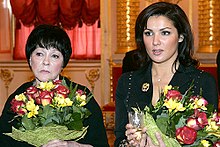Women in Russia

The poet Bella Akhmadulina (to the left) and Anna Netrebko
|
|
| Gender Inequality Index | |
|---|---|
| Value | 0.312 (2012) |
| Rank | 51st |
| Maternal mortality (per 100,000) | 34 (2010) |
| Women in parliament | 14% (2015) |
| Females over 25 with secondary education | 93.5% (2010) |
| Women in labour force | 64.8% employment rate, data from OECD, 2014 |
| Global Gender Gap Index | |
| Value | 0.6983 (2013) |
| Rank | 61st out of 144 |
The status and rights of women in Russia has been affected by culture, religion and social discourses.
The position of women in Russian society must be understood within the historical context of Russia. The history of Russia is rich and varied: the country has gone through numerous different regimes throughout the centuries. Archaeological evidence suggests that the present day territory of Russia was inhabited since prehistoric times: 1.5-million-year-old Oldowan flint tools were discovered in the Dagestan Akusha region of the north Caucasus, demonstrating the presence of early humans in Russia from a very early time. The direct ancestors of Russians are the Eastern Slavs and the Finno-Ugric peoples. For most of the 20th century, the history of Russia is essentially that of the Soviet Union. Its fall in 1991 led, as in most of the former communist bloc countries of Eastern Europe, to an economic collapse and other social problems. Women in Russia are not a monolithic group, because the country itself is very diverse: there are almost 200 national/ethnic groups in Russia (77.7% being Russians - as of 2010), and although most of the population is (at least nominally) Christian Orthodox, other religions are present too, such as Islam (approximately 6% - see Islam in Russia). Famous women in Russian history include Anna of Russia, Elizabeth of Russia, Catherine the Great, Yekaterina Vorontsova-Dashkova.
Women of eighteenth-century Russia were luckier than their European counterparts in some ways; in others, the life of a Russian woman was more difficult. The eighteenth-century was a time of social and legal changes that began to affect women in a way that they had never before experienced. Peter the Great ruled Russia from 1682–1725 and in that time brought about many changes to Russian culture, altering the orthodox traditions that had been observed since the fall of the Byzantine Empire. The three major social classes present during these reforms experienced changes in varying degrees according to their proximity to the tsar and urban settings where reforms could be more strictly enforced. Large cities underwent the westernization process more rapidly and successfully than the outlying rural villages. Noblewomen, merchant class women, and peasant (serf) women each witnessed Petrine reforms differently. For the lower classes it was not until the end of the eighteenth-century (during the time of Catherine the Great’s reign) that they began to see any changes at all. When these reforms did begin to change women’s lives legally, they also helped to expand their abilities socially. The Petrine reforms of this century allowed for more female participation in society, when before they were merely an afterthought as wives and mothers. “The change in women’s place in Russian society can be illustrated no better than by the fact that five women ruled the empire, in their own names, for a total of seventy years.”
...
Wikipedia
